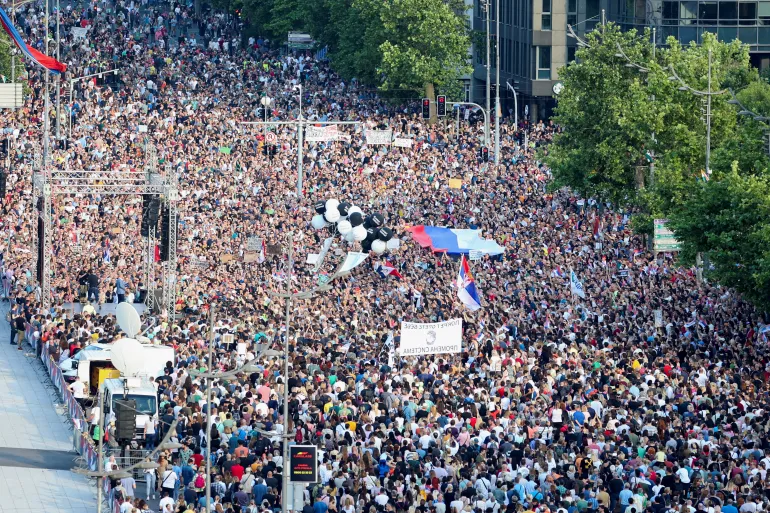
Belgrade and several other Serbian cities witnessed massive demonstrations on Saturday as tens of thousands of anti-government protesters voiced their discontent with President Aleksandar Vučić. This marked the seventh consecutive rally in the capital since May, with participants vowing to escalate their actions in a bid to challenge Vučić’s populist governance.
Organized by several pro-European opposition parties, the protests primarily accuse the government of perpetuating a culture of violence, particularly through television broadcasts. The recent spate of mass shootings, resulting in the tragic deaths of 18 individuals, served as a catalyst for the demonstrators’ outrage.
On May 3, a 13-year-old teenager killed nine classmates and a guard at a school in Belgrade, followed by another incident less than 48 hours later where a young man murdered eight people in two villages near the capital. Initially, the protests began as an expression of mourning but rapidly evolved into a broad movement denouncing President Vučić’s government.
Under the banner of “Serbia against violence,” simultaneous rallies took place on Saturday in Belgrade and the country’s main cities of Novi Sad, Kragujevac, and Niš. Thousands of people participated in these gatherings, as reported by local media. The organizers have cautioned that if their demands are not met, the movement will expand to ten other towns.
These demonstrations represent the largest wave of protests since the movement that preceded the downfall of former Serbian strongman President Slobodan Milošević in 2000. The protesters are demanding that the government revoke licenses of television channels broadcasting violent content and prohibit pro-government newspapers from exacerbating tensions by targeting political dissidents. Additionally, they are calling for the resignation of the interior minister and the head of the intelligence services.
“Either the violence stops, or Serbia does,” proclaimed Serbian journalist Smiljan Banjac to the crowd in Belgrade on Saturday. Criticism against President Vučić has persisted for years, with his opponents accusing him of employing increasingly authoritarian measures to stifle opposition voices and maintain control over media and state institutions. President Vučić has dismissed the protests as a “political” ploy and accused foreign powers of orchestrating them.
As the protests continue to gather momentum, Serbia finds itself at a pivotal juncture, with citizens demanding change and an end to violence while the government faces mounting pressure to address their concerns. The magnitude of these demonstrations underscores a growing dissatisfaction within the population, as they seek a more inclusive and accountable governance model.


